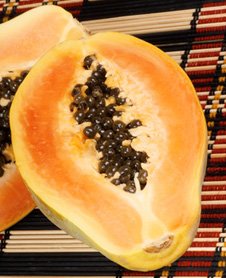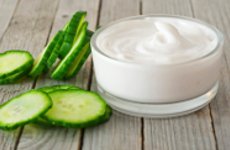JUNE 2013
SUMMER SKIN, NATURALLY

1. Know Your Limit. We tolerate the sun differently based on genetics. People with fair skin tend to burn much quicker and need less exposure. It is important to know what your threshold is. If you have fair skin, start with only 5 minutes of sun on your bare skin before using sun protection. If you have a darker skin tone, you might try a few minutes longer. It also depends on the location of the sun and the time of year. At the peak of summer, UVB rays can be especially potent. Use your best judgement and aim for smaller amounts of exposure more frequently to get the best immune boost.
2. Avoid Toxic Sunscreens. Many sunscreens on the market contain toxic chemicals that get absorbed directly into your bloodstream when applied to your skin. If you are going to be protecting your skin with sunscreen, use all-natural alternatives. One excellent resource to find the perfect sunscreen is the Environmental Working Group 2013 Guide to Safer Sunscreens.
3. Try a Cover-up. Another safe alternative is to cover your skin. UVB rays need to contact your skin directly to do damage. That is why we get tan lines in areas that are covered by our clothes. Some helpful coverups include bathing suit cover-ups and wraps, hats or shawls, or even shirts with long sleeves. If you are going to be adding layers of clothing as a cover-up option, it is important to stay cool and hydrated.
Sometimes, even our best attempts to avoid overexposure can fail, resulting in a sunburn. Or, maybe you have sun damage from the past. Here are some tips to help heal and repair the skin:
1. Aloe Vera. For immediate sunburns, apply a light layer of fresh aloe to the skin. If you have an aloe plant, simply snap off a few stems, break them open, and apply the pulp directly to your skin. The gel will not only cool the skin, research is showing that properties in the plant help moisturize and heal the skin. You can also get gels made with healing Aloe oil from your local health food store.
2. Antioxidants. To repair damage from the inside out, add potent antioxidants to your diet. These powerful nutrients help to both protect the skin and heal it from sun damage. Foods high in Vitamin C are especially healing for the skin such as papayas, bell peppers, strawberries, broccoli, and pineapple. Add these to your salads, fresh smoothies, or eat raw.
References
Will Rubbing Aloe Vera On Your Sunburn Help? University of Arkansas Medical Science.
Pizzorno, Joseph E., and Michael T. Murray. 1999.†Textbook of Natural Medicine. Edinburgh: Churchill Livingstone.
PAPAYA
Papayas are tropical fruits that are high in Vitamin C, providing over 300% of your
daily need in one serving. They are also high in Vitamin A, making them a great nutrient-rich food for the skin. Papayas have other amazing health benefits as well that make them a summer super food. They are rich in antioxidants, carotenes, flavonoids, and minerals. Because they are high in fiber, it helps the body absorb the sugars they contain at a slower rate. They help promote the health of the cardiovascular system, digestive system, and provide protection against colon cancer, rheumatoid arthritis, and macular degeneration. Because papaya contains the digestive enzyme, papain, it also helps aid in digestion and can reduce inflammation. To get more papaya in your diet consider eating it fresh, blending it in smoothies, or adding it to salads. Papaya seeds are edible, and some like their slightly peppery flavor but you do not have to eat the seeds to get the many health benefits of the fruit. Simply scoop them out and eat the Papaya like you would any other melon.

References
“Papaya.” World’s Healthiest Foods.
Rakhimov MR. Pharmacological Study of Papain From the Papaya Plant Cultivated in Uzbekistan (Article in Russian). Eksp Klin Farmakol 2000 May-Jun;63(3):55-7. 2000.
Wood, Rebecca. The Whole Foods Encyclopedia. New York, NY: Prentice-Hall Press; 1988. 1988. PMID:15220
RECIPE: HAWAIIAN POPSICLE
- 13.5 ounces coconut milk
- 2 cups fresh or frozen cubed Papaya
- 1 banana
Pour ingredients into a blender and puree. Pour into popsicle molds and freeze at least 4 hours. Serve

VITAMIN TRIO: C, D & E

United States Department of Agriculture, Agricultural Research Service: USDA Nutrient Database for Standard Reference, Release 13, 1999.
Mindell E. Earl Mindell’s Supplement Bible. Mindell paperback, 1998:20.
Bjelakovic G, Nikolova D, Gluud LL, Simonetti RG, Gluud C. Mortality in Randomized Trials of Antioxidant Supplements for Primary and Secondary Prevention: Systematic Review and Meta-Analysis. JAMA 2007;297:842-57.
Marz, R. (1999). Medical Nutrition. 2nd Edition. Omni-Press. Portland, OR: 235-241.
“Vitamin D and Skin Health.” Linus Pauling Institute Micronutrient Research for Optimal Health. Oregon State University Website.
TURMERIC (Curcuma longa)

References
“Turmeric.”World’s Healthiest Foods.
Aggarwal B. Paper presented at the U.S. Defense Department’s ‘Era of Hope’ Breast Cancer Research Program Meeting in Philadelphia, PA, October 5, 2005. Reported in NUTRAingredients.com/Europe “Turmeric Slows Breast Cancer Spread in Mice.”
Balasubramanian K. Molecular Orbital Basis for Yellow Curry Spice Curcumin’s Prevention of Alzheimer’s Disease. J. Agric. Food Chem., 54 (10), 3512 -3520, 2006. 10.1021/jf0603533 S0021-8561(06)00353-0, Web Release Date: April 20, 2006. 2006.
SUMMER SKIN WRAPS

cucumber
3 pieces of fresh aloe vera
Coarsely chop the cucumber and use a blender to make it into a smooth mass. Put the mass in a strainer to get rid of excess water. Remove the meat from the aloe vera and rinse it under running water (the yellow juice in aloe vera will be itchy on your skin so it needs to be washed off). Place the aloe meat in the blender and blend until smooth. Mix the cucumber and aloe together in a bowl to form a paste. Apply the paste to your skin and lightly wrap with a cool cotton cloth. Replace wrap every 5 minutes once the skin begins to warm up. This helps to keep the body cool, and keeps the sunburn from being aggravated by a buildup of excess heat.
Follow us on instagram
BLOG
Become an educated consumer with our Indigo Blogs and prevent dis-ease.
Our Doctors have been featured in:









